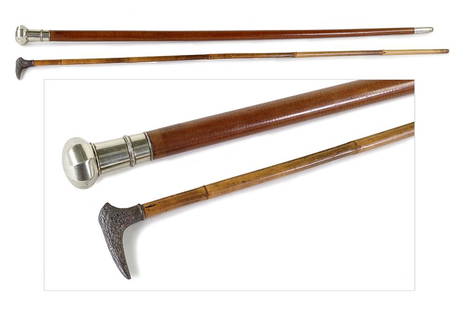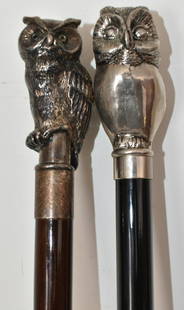
Two Walking Canes With Angled Ivory Handles, c. 1900
Similar Sale History
View More Items in Canes & Walking SticksRelated Canes & Walking Sticks
More Items in Canes & Walking Sticks
View MoreRecommended Accessories & Vanity Items
View More








Item Details
Description
Europe, c. 1900
Handle length: 9 and 10 cm
Overall length: 75.5 and 89 cm
Good condition
Two walking canes with angled ivory handles
The present set is composed of two walking canes with angled ivory and bone handles. One stick has a Malacca cane shaft with a plaited silver collar. The other reveals a palm wood shaft with a brass collar. The latter also features a metal tip at the lower end. The other walking cane is supported by a piece of yarn at the lower end.
The walking canes are in good condition with only small traces of age and use. One handle glued. The stick with the Malacca cane shaft measures 75.5 cm in length and has a handle of 9 cm. The other stick measures 89 cm in length and its handle measures 10 cm.
History of walking canes
Canes were predominantly used by men and as a means of support, but considerably rather as a walking accessory. The promenader grabbed the handle loosely and swung it in the rhythm of his steps. Walking sticks have existed since ancient times, when they were merely suitable branches found on the ground or broken off trees. In the early Middle Ages, canes were increasingly distributed, when their function as tools and weapons led to an increase in their popularity. Sophisticated society members and certain professionals had more elaborate canes. Especially during the 17th and 18th century, walking canes served as a symbol of social status and were often quite luxuriously crafted. Since the 19th century, the accessory also became common and fashionable in the middle classes: a cane was chosen according to how it would match with the user’s clothing. By the time of the Industrial Revolution in Europe, a so-called ‘system canes’ could conceal a variety of functions. These were often patented and examples may include both swords and firearm weapons, cigarette lighters, small mirrors, snuff boxes, whiskey bottles and glasses, musical instruments, medical equipment and many more. Since the mid-20th century, walking sticks are less widely-spread, but, due to their extensive history and great variety, they have become a popular collector's item. (cbo)
Shipping costs excl. statutory VAT and plus 2,5% (+VAT) shipping insurance.
Buyer's Premium
- 23.8%
Two Walking Canes With Angled Ivory Handles, c. 1900
Shipping & Pickup Options
Item located in Berlin, dePayment


















































![[Lafayette] Cane from USS Brandywine: ~33 inch wood cane with silver band affixed with an early 20th c. tag inscribed in ink: "Wood from USS Brandywine, begun, 1821, Washington, Ironclad(?), 1825. From Jas. H. and Wm. H. Sands, Annapolis,](https://p1.liveauctioneers.com/7226/322253/173251492_1_x.jpg?height=310&quality=70&version=1710004847)












![[CIVIL WAR] Soldier's Antietam Relic Walking Stick: Soldier's carved wooden walking stick relic. Carved in large block letters: "Antietam Battle Field Near Burnside Bridge." A soldier's relic taken from the famous "Burnside's Bridge" that played a pivo](https://p1.liveauctioneers.com/7226/325455/175169112_1_x.jpg?height=310&quality=70&version=1712370394)











